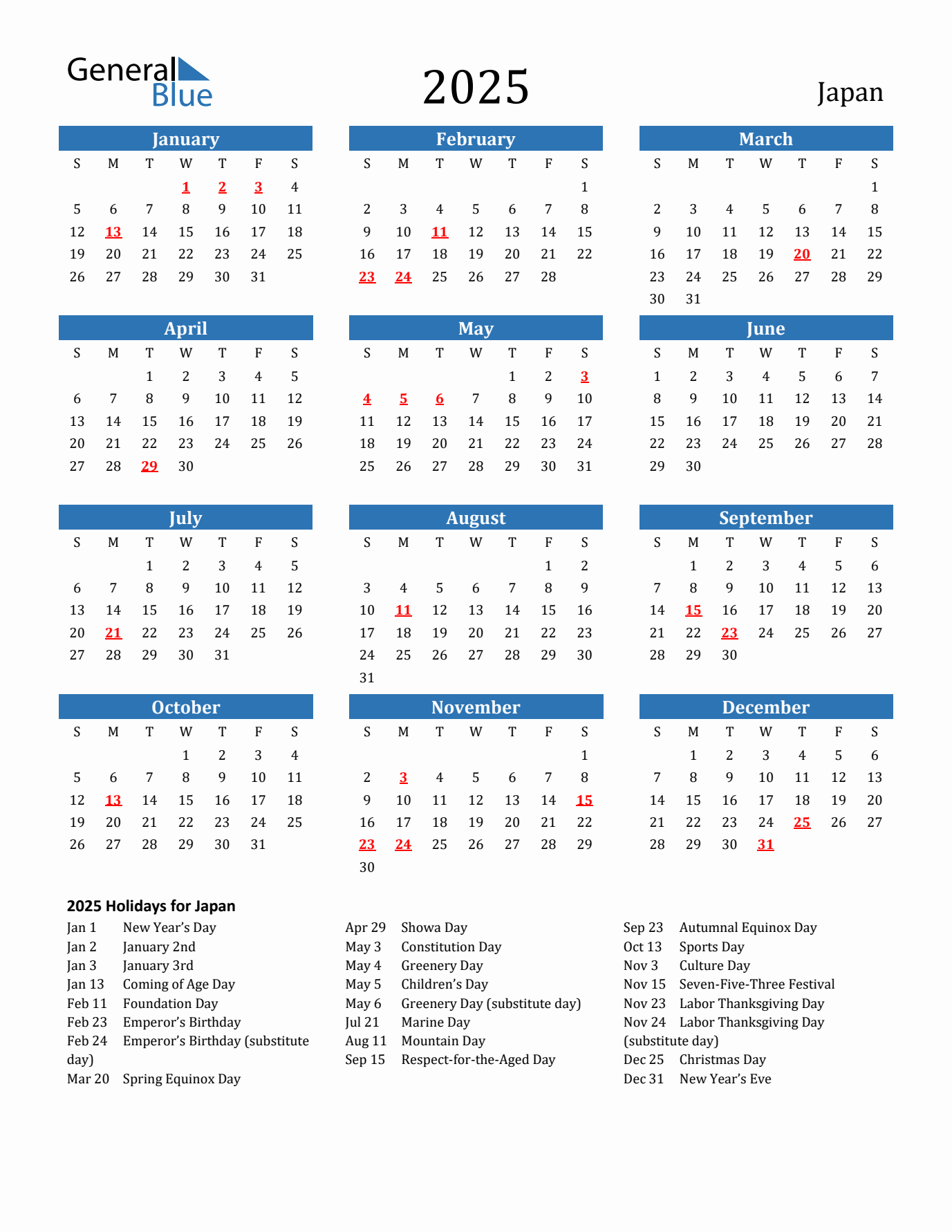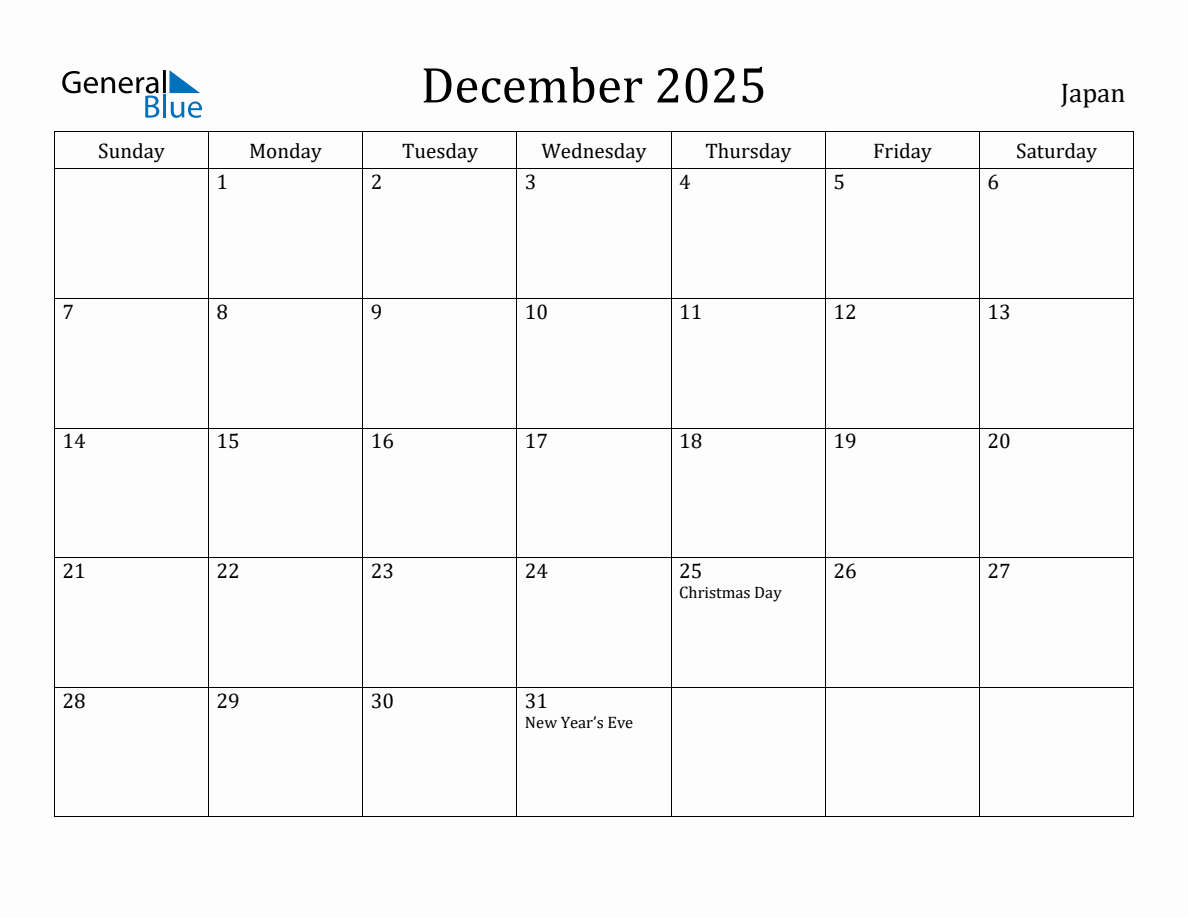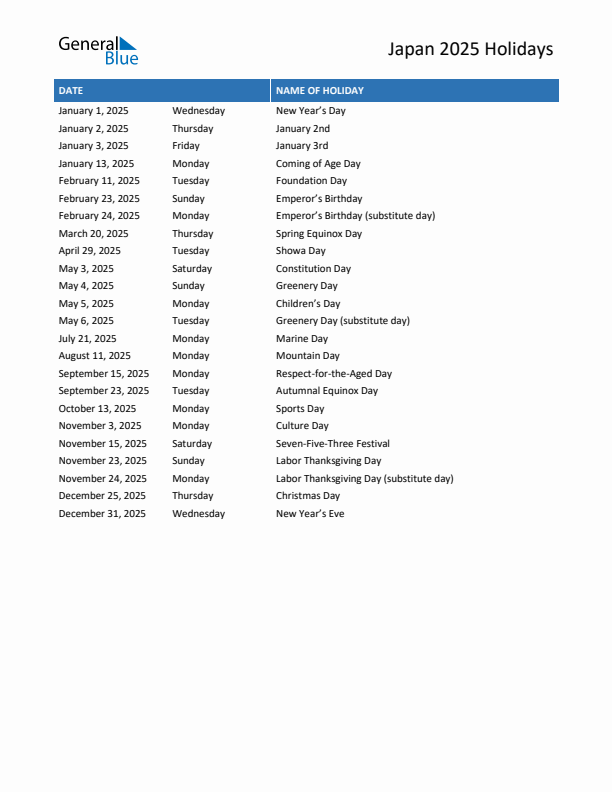Children's Day in Japan
When is Children's Day in Japan?
Children's Day in Japan is on May 5, 2026. It falls on Tuesday.
How many days until Children's Day in Japan?
There are 126 Days left until Children's Day in Japan.
Is Children's Day a public holiday in Japan?
Children’s Day or known locally by the Japanese as ‘Kodomo no Hi’, is a national holiday which occurs every 5th of May every year in Japan. From the name itself, this holiday is intended to celebrate the happiness of all children across the country. Children’s Day is primarily celebrated to wish the young kids not just happiness but also good health, good fortune, strength, growth, and future successes.
Origin of Children's Day
Children's Day is also part of one of the major holiday seasons in Japan, the Golden Week (series of national holidays within a seven-day period). It is said that among all the national holidays that form part of the country’s Golden Week, this holiday stands out the most. Being the last holiday to be celebrated on the said week, the day is filled with so many festive and extraordinary activities. Families, relatives, and friends tend to gather together to celebrate this holiday, with the children being on its center stage.
From Boy's Day (Tango no sekku) to Children's Day
According to the Japanese history records, the celebration of the Children’s Day in the country can be traced as early as 593 – 628 AD. Originally, this holiday was called Tango no sekku, meaning Boys’ Day. As a counterpart to Japan’s Hinamatsuri, meaning Girls’ Day which is celebrated on March 3, the Boys’ Day, as the name suggests, is intended only to celebrate the young boys in Japan. It’s a festival celebrated for the male children alone. However, this was changed in 1948. After the Japanese Post-War Constitution was created, the Japanese government decided to rename the holiday. From Tango no sekku or Boy’s Day, it was renamed officially to Children’s Day instead. Thus, because of the change of the holiday itself, May 5 is now celebrated not just for the boys’ alone but it now recognizes all the young children in the country regardless of gender. Both male and female kids are now entitled to enjoy the holiday with the same vigor as the Children’s Day is established to celebrate the happiness of all children residing in the country. Nevertheless, despite of the holiday’s name change, many of the Japanese would still treat the Children’s Day as the Boys’ Day holiday considering that the female kids still actually have a day of their own to celebrate with. Girls’ Day or Hinamatsuri as what it’s called, is still observed every 3rd of March in Japan even up until present.
Children's Day Traditions in Japan
The celebration for Children’s Day is observed not just in Japan, but even to other countries around the globe. Its celebration varies per country since it’s dependent on the practices that the country is accustomed to. Japan, for instance, has its own unique customs and traditions practiced in accordance to the celebration of the Children’s Day. The Children’s Day is observed annually in the country every 5th of May. Since this is a public holiday, most company offices would temporarily shut down on this day. Same thing goes with the schools and the government institutions. Nonetheless, several other establishments would remain open and accessible to the public such as shops, convenience stores, supermarkets, restaurants, amusement parks, resorts, tourist attractions, and others.
Flying of Koinobori
The Japanese have always been popular because of how beautiful their culture is. The celebrations arranged on Children’s Day is definitely one of the reasons for the country’s uniqueness. What’s fascinating about the celebrations done on this holiday is the fact that each activity executed has some symbol or meaning to it. Several activities are being held during the holiday and one of those include the raising or flying of the koinobori which is observed all over Japan. ‘Koinobori’, being the symbol for the Children’s Day, could be seen anywhere in the country. Koinobori are carp-shaped flags prepared just for this day. These carp-shaped flags (a carp is a type of freshwater fish) or fish-shaped flags are going to be raised and flown as part of the celebration of the Children’s Day. Because of its appearance, upon raising, it looks like there are fishes swimming in the sky, which would always make both the children and adults left admiring it. These carp-shaped streamers flown on the same day is something one could not see very often. Raising the koinobori is the main event during this day and is expected to be observed all around the country. Japanese people would normally prepare for these carp-shaped flags ahead of time to make sure it was exquisitely beautified. What’s fascinating about this carp-shaped flags though, aside from the fact that it’s very pleasant to look at since its multicolored, is the meaning associated with it. The Japanese believed that the carps symbolize bravery, perseverance, and courage. Thus, by using them as basis in creating the streamers/flags, they also hope that their children would also acquire the same traits as they grow older and face bigger challenges.
Before these flags/streamers are raised, it is typical for the Japanese to make sure that the carp on the topmost part with the largest size is the black carp (called Magoi) since this represents the father, followed by a smaller carp usually in red color or sometimes pink (called Higoi) which should represent the mother, and the last carp at the bottom part should represent the child/children. The children’s carp color could either be blue, green, yellow, or orange. The number of colored fish-shaped flags found at the bottom part (below the parents’ carps) represent the number of child/children a family has. At present, during the holiday, these fish-shaped flags could be seen anywhere in Japan, not just on the Japanese families’ balconies, but even in places like shops, restaurants, parks, monuments, and others.
Samurai Doll
Displaying a samurai doll of famous warriors or decorating it with helmet miniatures/ samurai helmets called ‘kabuto’ is another customary practice done by the Japanese during the celebration of the Children’s Day. These decorations are usually found in the living room of a typical Japanese family. For most kids, making a samurai helmet out of paper is also another exciting activity. They would even make sure that it’s big enough so they can wear it outside. While some kids do this, there are also other children who prefer to participate to events arranged for this holiday. During the celebration, a kyogen is also held at some place (before, it was in Yokohama Noh Theater) and is open for children who are willing to join. A ‘kyogen’ is a comic theater arranged for the day wherein the participants are children, showing their talents in acting/performing. Families, friends, and relatives would come to watch this event together with other spectators who wanted to support and enjoy the performances of the little kids.
Syobuyu
In addition, another Japanese tradition practiced during this holiday is also taking a hot bath on water filled with floating iris leaves and roots. These baths are called ‘syobuyu’. The Japanese people primarily believed that by having these type of baths, they can ward off the misfortune and all other evil things away from their lives.
Common Foods Frepared on Children's Day
Similar to other national holidays in Japan where special foods are served, Children’s Day has its own share of special dishes prepared by the Japanese as well. There are actually a variety of foods to choose from, however, there are two specific foods that one need not miss out during the holiday. These are the Kashiwa-mochi dish (sticky rice cakes filled with sweet red bean paste and wrapped in oak leaves) and the Chimaki dish (sticky sweet rice wrapped in an iris or bamboo leaves). Other dishes prepared for this day also include: Sekihan (Japanese azuki red bean rice), Chirashi Sushi, Ushio-Jiru (Japanese clear clam soup), Chikuzenni, Karaage (Japanese fried chicken), Harumaki (Spring rolls), Ebi Fry (Japanese fried shrimp), Hambagu (Hamburger steak), and Japanese potato salad. For the drinks, the lily liquor is the best choice for the day.
| Year | Date | Day | Holiday |
|---|---|---|---|
| 2026 | May 05 | Tuesday | Children's Day |
| 2027 | May 05 | Wednesday | Children's Day |
| 2028 | May 05 | Friday | Children's Day |
| 2029 | May 05 | Saturday | Children's Day |
| 2030 | May 05 | Sunday | Children's Day |
| 2031 | May 05 | Monday | Children's Day |
| Holiday | Date |
|---|---|
| New Year's Eve | December 31, 2025 |
| New Year's Day | January 01, 2026 |
| January 2nd | January 02, 2026 |
Download or print free 2025 calendar which includes the list of holidays in United States. Free holiday calendar templates in more than 130 countries are provided in PDF, Excel, and Microsoft Word format. For those who like to get a calendar that starts on Monday, we also have ISO calendar.
The December 2025 monthly calendar for the United States shows the holidays for the month, which is helpful in planning schedule and events in reference to the upcoming holidays in the US. It is available in PDF, Microsoft Word and Microsoft Excel formats. You may select your preferred orientation and preferred start of week since we have Monday start calendar or Sunday start calendar.
If you are looking for just a list of holidays in the United States for the year 2025, we have that available in PDF, Word and Excel formats. This can be helpful for those who like to keep track of the holidays, be it for travel, work or any other purposes. It is free to use, just like the rest of our templates. You can choose from Letter, Legal and A4 paper sizes.


